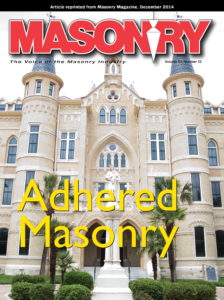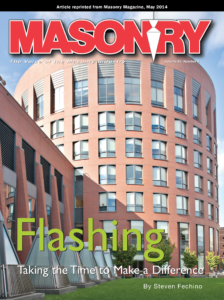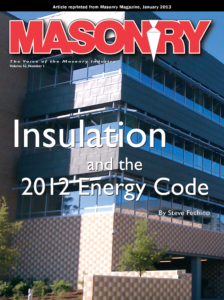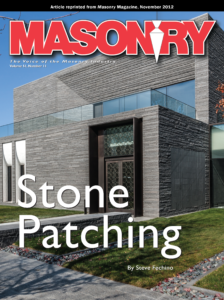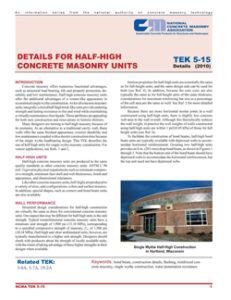Articles
June 2019 – A Contractor’s Struggle
When a manufacturer produces a new product that is performance-, cost- and labor-efficient, it seems as if everyone would want to begin using it immediately. The acceptance by the design team is only the first step in using the product; the installer or masonry contractor must be willing to try the new way in a competitive market, knowing that the “way I have always done this” would have been performed without the unknown factors of a new product.
Read MoreFebruary 2019 – Designing Adhered Masonry Veneer Part 2
A look at weather resistive barriers. Weather resistant barriers are commonly found on residential and light commercial construction projects. The discussion will give insight on properly selecting the correct material. When selecting house wrap material, the perm rating should be part of your consideration as the vapor that passes into the wall must be able to escape to the outside.
Read MoreNovember 2018 – Design Changes for Long Lasting Adhered Veneer Masonry Performance
In the late-1950s and early-1960s, adhered veneers began filling the need for alternative veneers. With origins, for the most part, in California, concrete units were available for use as accents on buildings that were typically clad with stucco or aluminum siding. In dryer environments where originally installed, long lifespans were achieved, and performance of the materials was aesthetically pleasing.
Read MoreAugust 2018 – Designing an Adhered Masonry Veneer
Walls today offer better technology and water protection than in years past. Adhered masonry veneers are better designed and perform more efficiently when the entire wall system is considered before and during installations. Many of the improvements are a result of changes in materials, improvements based on testing, higher performance by design and installation improvements. Here, we look at products commonly found in adhered masonry wall sections and how they individually can affect thin veneer walls.
Read MoreJune 2018 – Flood Repair Damage Article
A flood is an unexpected and terrible event to witness and endure. Recently, our nation has experienced more severe floods than in the past, and flooding is a difficult natural disaster with which to contend. Flood water will find its way into everything you own below the water level line.
Mortar Net Solutions is offering homeowners a way to keep any salvaged personal possessions secure during the rebuild of homes with masonry facades.
Read MoreAugust 2017 – Flashing for Adhered Masonry Veneer
Adhered masonry veneers are a popular cladding choice today as adhered masonry materials have improved significantly during the last few years. The texture of cultured stone is more durable and realistic, offering a better solution for new and updated veneers. Many masons are installing...
Read MoreMay 2016 – Water in the Walls: A Practical Guide to Wall Drainage and Flashing Installation
When a discussion begins regarding cavity wall drainage, flashing or adhered veneer drainage, most of the time it begins with the saying, “Masonry leaks.” Well, yes, masonry does leak, but the systems in place to support the building envelope can prevent the water from entering the substrate, living space or surrounding building materials, thereby preventing any saturation that can lead to further problems.
Read MoreOctober 2015 – Navigating Adhered Masonry Veneer
Adhered Masonry veneer is a cost-effective way for a home owner or commercial property owner to keep the appearance of masonry in the façade, when budgets or design considerations don’t allow the use of full-sized masonry units.
Read More
Many masons have learned to install these veneers as a way to secure a contract or to make a little extra money on the side. Here are a few lessons learned by a guy whose first adhered masonry veneer job was a poorly understood, planned and managed mess.August 2015 – Sealants, Adhesives and Their Application to Mortar Net Products
The performance of sealants and adhesives applied to the substrates used in various Mortar Net Solutions products is critical to the performance of the systems in which they are used. This document provides background information on the use of sealants and adhesives, discusses test methods and results, and concludes with recommendations on the use of MPE-1 and BTL-1 with other products by Mortar Net Solutions.
Read MoreApril 2015 – Choosing the Right Anchor for the Job
We use anchoring and reinforcement on every project, whether restoration or new construction. The types of anchors generally are based on what veneer we are anchoring, the weight of the veneer, the condition of the substrate and challenges that are present in installing the anchors.
Following is a brief look at some of the anchors that work; what we may not have considered as an option; what may be new; and a few that should no longer be used.
Read MoreDecember 2014 – Addubg Drainage to Stone Veneers and Adhered Masonry
Cultured stone has been around for a long time, and many of us have become quite proficient in installing the “lick-and-stick” products as part of an adhered veneer wall. These veneered walls consist of a weather-resistant barrier, drainage plane, lath, weep screed, scratch coat and veneer material.
Read More
Newly improved veneer mortars have changed recently in a positive way.December 2014 – The Building Envelope: Buzzword or Trend?
You may have noticed an increase in the use of the word "System" lately. As you read through the articles and glance at the various advertisements, you may notice the "systemization" theme repeated over and over again, and a growing use of the term. What exactly does "system" or "systemization" mean?
Read MoreMay 2014 – Flashing: Taking the Time to Make a Difference
A brief history of flashing, and how something that we see such a little of on a completed project can make the difference in how the project turns out.
Read MoreMarch 2011 – Rain Bring on the Rain
Moisture management: We all know the term, and we all know the processes and materials. But do we know if we are actually installing our work correctly?
Read More
Yes, many of us cover and protect our materials; however, materials saturated from the elements are still installed in our projects, introducing the first moisture to our cavities.January 2014 – The Wave of the Future: Book Smart Masons
Masonry is an industry that has endured the test of time. Education within this industry will continue to evolve as new products, equipment and designs create the need for updated training for our apprentices and journeymen.
Read More
The National Center for Continuing Education and Research (NCCER) has been on the forefront of the educational update since 1989, when it published the first series of masonry textbooks for the training of secondary and post-secondary students. NCCER is a not-for-profit 501(c)(3) education foundation created to fill the need for standardized masonry curriculum. NCCER is recognized by the construction industry, covering more than 70 different disciplines as the training, assessment, certification and career development standard for the craft professional.Best Practices for Selection and Installation of Expanded Metal Lath Products
Specifying the appropriate metal lath product for the application and installing it properly has a dramatic impact on the long-term stability of a building’s exterior cladding. Fortunately, there are various building codes and industry standards that are excellent guides to best practices for product specification and installation.
Download the White PaperJanuary 2013 – Insulation and the 2012 Energy Code
Codes: They can be confusing to keep up with as we manage our busy masonry operations. Many of us have heard that the 2012 Energy Code will bring tremendous change to the industry. However, the changes to the code actually are widespread to the building industry and are met with compliance, with many of the current systems and products we are installing daily.
Read More
The code does have many changes. For instance, entire heating, ventilation and air conditioning (HVAC) systems will require improvements to the mechanical systems and duct work.November 2012 – Patching: Extending the Life of Masonry
Patching of masonry materials during a new construction project is typically a line item that was not planned during the estimating phase of the project. Understanding the products commonly available for patching, capabilities, compatibility and limits of each product will enable you to make better choices when selecting the products required for each patching condition. Masonry restoration contractors typically are experts in the field of patching as a major portion of their business can be repairing historic structures with deteriorated stone, concrete and terra cotta.
Learn how proper patching can extend the life of masonry.October 2012 – Moisture Management in Masonry Buildings
Masonry Construction, one of the oldest building systems in the world, requires a complex integration of a variety of elements to control moisture. The construction of a masonry building requires the knowledge of how this material weathers and reacts to seasonal changes such as snow, sleet, wind-driven rain, and humidity. Ancient civilizations building in equatorial zones using 3-foot-thick walls did not have to worry about a freeze-thaw cycle when they chose masonry, stucco, and brick as their most common building material. However, as civilization moved north to more temperate climates, new construction methods reduced the impact of moisture from seasonal temperature variations on buildings.
Learn how unitized flashing provides an integrated design solutionJuly 2012 – Seeing is Understanding
All information shared is only as good as the person communicating the concern. For example, when I am explaining a masonry situation that requires some assistance from a more experienced co-worker, I need to be on my game. I have access to a variety of expertise at my fingertips - people who could jump in a truck and come to a jobsite without adding expense to my job. That is what we all need: someone there who can help.
Learn how Mortar Net Solutions is using video to help masons meet job-site challengesJune 2012 – Rules Never to be Broken
As with all things, masonry has rules that will and will not change over time.
Learn the rules for installing flashing correctly
Rule No. 1 - Masons get paid for what they lay on the wall, not for effort.
Rule No. 2 - Completing a job correctly will cost the mason four-times less than a mistake. One: removal of defective work. Two: replacement of defective work. Three and Four: the two jobs that were not completed while the repair work was performed.
Rule No. 3 - A wall without flashing completed properly has a 95 percent chance of leaking as opposed to a wall that is flashed correctly, which has almost no chance of leaking.December 2010 – Flashed Before Your Eyes
We all know, the economic downfall is not directly related to how we individually run our businesses. It does, however, create opportunities for our businesses to be operated differently. For example, our yards no longer have surplus wall wire, anchors, or rolls of flashing lying around, and I'll bet payrolls are smaller than desired. We are all affected by this, and we have to work through it. We have to be a bit stonger and a bit smarter than before, so we can look back on this tough time later.
Learn about proper flashing installationNovember 2010 – CMU Historic Preservation: Kahn Bath House
Who'd have guessed that a tiny, decrepit CMU building near Trenton, NJ where swimmers at an old day camp used to change their clothes, would turn out to be an architectural treasure?Practically nobody, of course. Which may be why this starkly simple structure - designed by the late Louis Kahn, the subject of an Oscar-nominated documentary film, "My Architect" - was about to be demolished and replaced by high density housing.
Learn how BlockFlash was used in restoring an architectural treasure2010 – National Concrete Masonry Association TEK 5-15 Details
Many designers are turning to half-high masonry because of its economy. As an alternative to a traditional cavity wall, these walls offer the same finished appearance, exterior durability and low maintenance coupled with a shorter construction time because of the single wythe loadbearing design.
Learn why the NCMA features BlockFlash in their TEK Note 5-15. "Details For Half-High Concrete Masonry Units"January 2010 – The Sustainability of Masonry
Joe Montalvo, who owns Montalvo's Masonry, in Ft. Worth, Texas, was understandably pleased when he won the bid for a new CVS Pharmacy in Midwest City, Okla. By some measures, CVS is the nation's largest chain of retail pharmacies. The architects, Carter & Burgess of Ft. Worth (later acquired by Jacobs Engineering Group Inc.), had specified a reddish-colored, split-face, eight-inch CMU for much of the new store's single wythe exterior walls.
Learn how a mason saved money by using BlockFlash instead of step-flashing on an architectural block buildingApril 2009 – A Few Bucks of Prevention
In 2007, just weeks after it was completed, a four-story, 75,000-square-foot, state-owned building costing $10 million began leaking at several of its interior window heads.
Read a case study about the cost of poor flashing installation
Before it was over, those leaking windows turned into a nine-month, $1,750,000 remediation nightmare. It included a total re-cladding and numerous other repairs, and the replacement of its copper fabric flashing with a product that didn't even exist when the building was being designed.September 2008 – Rehabs & Restorations
Asbury Tower is a 26-story, affordable housing community for seniors. The 35-year-old facility has 347 apartments and is located on the ocean in Asbury Park, NJ. While the building was structurally sound, sections of the brick facade had begun falling off. LAN Associates, Engineering, Planning, Architecture, Surveying Inc., based in Midland Park, NJ., has been retained to reengineer the skin and spec out the project. The project also includes mechanical upgrades, to air conditioning and sprinkler systems as well as interior upgrades, including new kitchens and bathrooms.
Read a case study about how TotalFlash was used in the Asbury Tower rehab projectMarch 2005 – Children’s Health
Previous studies of how parental atopy and exposure to dampness and molds contribute to the risk of asthma have been mainly cross-sectional or prevalent case-control studies, where selection and information bias and temporarily constitute problems. We assessed longitudinally the independent and joint effects of parental atopy and exposure to molds in dwellings on the development of asthma in childhood.
Learn why it's so important to prevent mold










